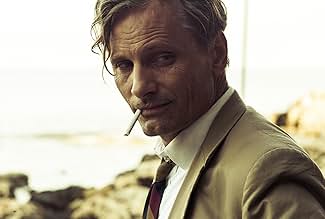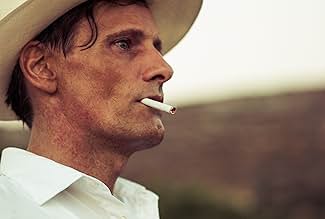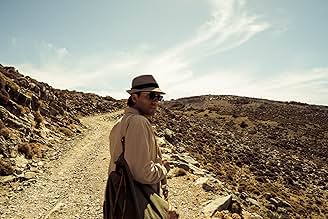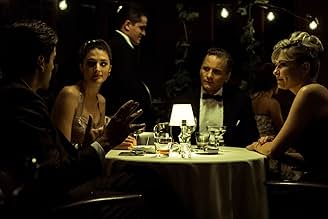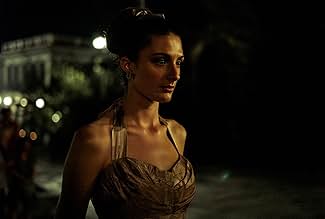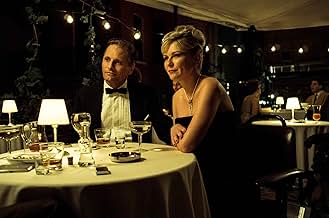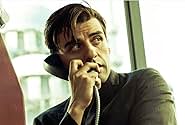AVALIAÇÃO DA IMDb
6,2/10
35 mil
SUA AVALIAÇÃO
Um thriller centrado em um vigarista, sua esposa e um estranho que foge de Atenas depois que um deles se envolve na morte de um detetive particular.Um thriller centrado em um vigarista, sua esposa e um estranho que foge de Atenas depois que um deles se envolve na morte de um detetive particular.Um thriller centrado em um vigarista, sua esposa e um estranho que foge de Atenas depois que um deles se envolve na morte de um detetive particular.
- Direção
- Roteiristas
- Artistas
- Prêmios
- 3 indicações no total
Babis Hatzidakis
- Stall Keeper
- (as Babis Chatzidakis)
Stella Fyrogeni
- Barmaid
- (as Stela Fyrogeni)
- Direção
- Roteiristas
- Elenco e equipe completos
- Produção, bilheteria e muito mais no IMDbPro
Avaliações em destaque
An old school, Hitchcockian style thriller from the writer behind Drive, The Two Faces of January commences with sexy, mysterious intrigue, but slowly dovetails into a soggy noodle. Shot against the glorious, sun-drenched Greek landscape by cinematographer Marcel Zyskind and boasting immaculate costume and set design befitting its 1960s period, January looks a million bucks, yet this can't cover up the fact the final hour is bland and devoid of tension. One of the finest (and underrated) actors of our generation, Oscar Isaac is once again astounding despite his failing surrounds, here portraying the smooth, enigmatic operator who gets in over his head when he witnesses a crime by an attractive American couple. As the wealthy tourists with a secret, Kirsten Dunst and Viggo Mortensen are another major weakness, the duo sharing zero spark together and Mortensen in particular possessing all the charisma of a plank of wood. It's a noble directorial debut from screenwriter Hossein Amini, but remains a missed opportunity in a subgenre not visited nearly enough.
'The to faces of January' is an old-fashioned, decent thriller with a nice sixties setting and solid acting. Everything about it is immaculate. The plot is intelligent enough: a couple of rich tourists meet a young American tour guide, who accidentally witnesses the husband committing a crime. One thing leads to another, and soon enough the guide is caught in a web of lies and deceit, and it becomes impossible to escape without incriminating himself. The crime story is spiced up by the mutual romantic attraction between the guide and the young wife. There is even a sort of life lesson included: money is the root of all evil.
The movie is well worth seeing, if only because it is nice to see a film that's not experimental, violent, provocative, filled with special effects or in one way or another trying to be hip or trendy.
I can see why so many reviewers make references to Hitchcock. The film is set in the early sixties, the era in which Hitch made some of his best films like 'The Birds' or 'Marnie'. Still, this film lacks the touch of a genius like Hitchcock. The characters have no extra psychological layers, and the unconventional scenes and themes that make the Hitchcock-movies so special, are absent in this film.
The movie is well worth seeing, if only because it is nice to see a film that's not experimental, violent, provocative, filled with special effects or in one way or another trying to be hip or trendy.
I can see why so many reviewers make references to Hitchcock. The film is set in the early sixties, the era in which Hitch made some of his best films like 'The Birds' or 'Marnie'. Still, this film lacks the touch of a genius like Hitchcock. The characters have no extra psychological layers, and the unconventional scenes and themes that make the Hitchcock-movies so special, are absent in this film.
Adapted by its director, Hossein Amini, from a little known novel by Patricia Highsmith "The Two Faces of January" turns out to be a highly satisfying tale of murder most foul very typical of Miss Highsmith. OK, so it's not on the same level as "The Talented Mr Ripley", "Plein Soleil" or "Strangers on a Train" but with its emphasis on plot rather than 'action' it's still a cut above a good many of today's so-called thrillers. Also typical of Highsmith is that the principal relationship in the film is between two men, (though one of them is married while the other starts to fall for the wife). The married one is Viggo Mortensen, apparently rich and touring Greece but also harboring a dark secret. The wife is pert little Kirsten Dunst and the man who falls for her is tour guide Oscar Issac. At first Issac thinks he has the upper hand, swindling Mortensen out of a few thousand dollars only to realize quite early in their relationship that he has bitten off more than he can chew. After awhile Dundst's character becomes almost redundant as the men start to play power games with each other. Whereas the male/male relationships in other Highsmith adaptations were mostly homo-erotic with at least one of the characters clearly drawn as gay. Here the relationship is meant to evoke a father and a son, (Issac's character has issues with his dead father). This slightly dilutes the dark heart of the picture. Movies like "The Talented Mr Ripley" and "Strangers on a Train" worked as well as they did because the villain was clearly homosexual and psychopathic and you never knew where his temper and jealous rages might take him. In this movie Mortensen is undoubtedly the jealous straight guy while Issac is just too nice, (he's too sweet to be a real con-man). Still, all three leading players are excellent and Amini tightens the screws very nicely as the film progresses. Filmed, for the most part, in Greece it will also prove something of a boost for the Greek Tourist Board this summer.
I have to applaud Hosseini's directorial debut. "The Two Faces Of January" takes us mostly to the 1960's Greece, with three main characters in focus.
Beautifully shot, this visually stunning period-piece (if I can call it that) relies on story and characters rather than trying to impress with extravagant plot twists and special effects. The narrative is very well balanced and restrained from the hyperactive traps of modern cinematic storytelling.
Good acting from everyone involved and my compliments to the music composer too, for providing a very fitting soundtrack.
This is classic film making. Nothing innovative but very beautiful to look at, a fitting choice to watch on a lonely evening.
Beautifully shot, this visually stunning period-piece (if I can call it that) relies on story and characters rather than trying to impress with extravagant plot twists and special effects. The narrative is very well balanced and restrained from the hyperactive traps of modern cinematic storytelling.
Good acting from everyone involved and my compliments to the music composer too, for providing a very fitting soundtrack.
This is classic film making. Nothing innovative but very beautiful to look at, a fitting choice to watch on a lonely evening.
Film opens at the Parthenon in Athens. A young male guide, played by Oscar Isaac, is guiding some impressionable girls. An older couple enter the scene. The male, played by Viggo Mortensen, is mature. His younger wife, played by Kirsten Dunst, looks like Doris Day. Thus we seem catapulted into the Hitchcock era. Film is in fact set in 1962, and all scenes seem authentic.
A central theme of far too many Hitchcock films to list, is that of an innocent man caught up in events over which he has no control. In this film, however, we quickly find that Mr Mortensen's character is no innocent. He is, however, quickly thrust into events that are out of his control.
Within the central trio of characters, it is unclear what are their individual motives, or, who is trying to con who. The sexual chemistry and tensions remind of 'Knife in the Water' (1962).
Film is a true Hitchcockian-style suspense movie rather than a thriller. As the tension rises so does the music, which also is pure Hitchcockian, and could easily have been lifted in great chunks from one or more of his movies.
As the tension rises, so too does the pace. From the start, the film moves at a decent pace, but this builds as the film progresses, and the pace gets faster and faster. Great camera shots, great chases, and iconic scenes, also suggest homage to 'The Third Man (1949).
All location shooting was superb. This reviewer, once attempting to follow in the footsteps of Plato, got lost in the mountains, and had to be rescued by shepherds. So it was with a fond familiarity that I saw those same mountains.
One explanation for the Hitchcockian-feel to the movie can be explained by the fact that the film is based on a novel by Patricia Highsmith. Alfred Hitchcock's classic 1951 film 'Strangers on a Train' was also based on a novel by Miss Highsmith. Thus perhaps it may be more accurate to describe the feel and touch of the movie as Highsmithian rather than Hitchcockian. Miss Highsmith is also the origin of the 'Ripley' stories.
This flawless and faultless masterpiece of a film, is the first full-length film directed by Hossein Amini. He also wrote the screenplay.
This film will appeal to all, though the 12A certificate means that it is unsuitable for young children. Suitable for all others, it is very suitable, and it will be very much appreciated, by classicists and Hitchcock fans.
A masterpiece! 10/10!
A central theme of far too many Hitchcock films to list, is that of an innocent man caught up in events over which he has no control. In this film, however, we quickly find that Mr Mortensen's character is no innocent. He is, however, quickly thrust into events that are out of his control.
Within the central trio of characters, it is unclear what are their individual motives, or, who is trying to con who. The sexual chemistry and tensions remind of 'Knife in the Water' (1962).
Film is a true Hitchcockian-style suspense movie rather than a thriller. As the tension rises so does the music, which also is pure Hitchcockian, and could easily have been lifted in great chunks from one or more of his movies.
As the tension rises, so too does the pace. From the start, the film moves at a decent pace, but this builds as the film progresses, and the pace gets faster and faster. Great camera shots, great chases, and iconic scenes, also suggest homage to 'The Third Man (1949).
All location shooting was superb. This reviewer, once attempting to follow in the footsteps of Plato, got lost in the mountains, and had to be rescued by shepherds. So it was with a fond familiarity that I saw those same mountains.
One explanation for the Hitchcockian-feel to the movie can be explained by the fact that the film is based on a novel by Patricia Highsmith. Alfred Hitchcock's classic 1951 film 'Strangers on a Train' was also based on a novel by Miss Highsmith. Thus perhaps it may be more accurate to describe the feel and touch of the movie as Highsmithian rather than Hitchcockian. Miss Highsmith is also the origin of the 'Ripley' stories.
This flawless and faultless masterpiece of a film, is the first full-length film directed by Hossein Amini. He also wrote the screenplay.
This film will appeal to all, though the 12A certificate means that it is unsuitable for young children. Suitable for all others, it is very suitable, and it will be very much appreciated, by classicists and Hitchcock fans.
A masterpiece! 10/10!
Você sabia?
- CuriosidadesViggo Mortensen on his character's wardrobe: "I particularly liked the white linen suit that you see in the poster that Chester wears, and in a way that's another character in the movie because the journey of that beautiful cream-colored linen suit, on the Acropolis in the sunshine in the beginning, this immaculate, perfect, fits perfectly, looks great. You see that suit at the very end of the story, and that suit's been through it, it's a bit torn, it's frayed, it's not as clean as it was, it's suffered almost as much as the man wearing the suit."
- Erros de gravaçãoIn the beginning Rydal recounts the legend of Aegeus on the steps of the Acropolis and says that it was there that Aegeus jumped to his death after his son, Theseus returned from Crete and forgot to change the black sails to white to denote his success. This is untrue; you would not be able to see the Aegean from the Acropolis, anyway. According to the legend Aegeus was waiting for the ships to arrive at Cape Sounion and when he saw the black sails he plunged into the sea (which is called the Aegean Sea after him). It is unlikely that a tour guide would not know how to recount the legend properly.
- Citações
Chester MacFarland: I'm sorry I disappointed you.
- Cenas durante ou pós-créditosAfter the production company logos, there are no opening credits.
- ConexõesFeatured in Film '72: Episode dated 5 March 2014 (2014)
Principais escolhas
Faça login para avaliar e ver a lista de recomendações personalizadas
- How long is The Two Faces of January?Fornecido pela Alexa
Detalhes
- Data de lançamento
- Países de origem
- Centrais de atendimento oficiais
- Idiomas
- Também conhecido como
- The Two Faces of January
- Locações de filme
- Empresas de produção
- Consulte mais créditos da empresa na IMDbPro
Bilheteria
- Orçamento
- US$ 31.000.000 (estimativa)
- Faturamento bruto nos EUA e Canadá
- US$ 507.463
- Fim de semana de estreia nos EUA e Canadá
- US$ 43.116
- 28 de set. de 2014
- Faturamento bruto mundial
- US$ 13.551.951
- Tempo de duração1 hora 36 minutos
- Cor
- Mixagem de som
- Proporção
- 2.35 : 1
Contribua para esta página
Sugerir uma alteração ou adicionar conteúdo ausente

Principal brecha
By what name was As Duas Faces de Janeiro (2014) officially released in India in English?
Responda






